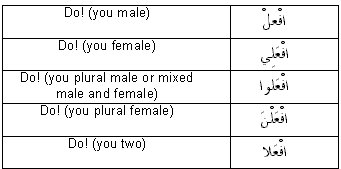The Present Tense 
We continue with a brief summary of grammar terms and explanations. The first lesson is now located in the archived tidbit lessons.
Present tense verbs are not “built” ![]() ; instead they are conjugated. It is to be noted that there is no separate future tense, instead the future is formed by adding a letter
; instead they are conjugated. It is to be noted that there is no separate future tense, instead the future is formed by adding a letter ![]() on the beginning of a present tense verb, or by inserting the word
on the beginning of a present tense verb, or by inserting the word ![]() before a present tense verb. The endings of the present tense verbs can be affected by certain letters before the verb. For example:
before a present tense verb. The endings of the present tense verbs can be affected by certain letters before the verb. For example: ![]() or
or ![]() (called
(called ![]() letters) cause the present tense verb to have a fat-h on the last letter, or if it is a form of verb that has an extra
letters) cause the present tense verb to have a fat-h on the last letter, or if it is a form of verb that has an extra ![]() added on the end of the verb, the extra
added on the end of the verb, the extra ![]() on the end is dropped. Other letters such as
on the end is dropped. Other letters such as ![]() or
or ![]() , (called
, (called ![]() letters) cause the last letter on the verb to have sukoon, or if it is a form of the verb that takes an extra noon, the extra
letters) cause the last letter on the verb to have sukoon, or if it is a form of the verb that takes an extra noon, the extra ![]() on the end of the verb is dropped, or if is a verb with a
on the end of the verb is dropped, or if is a verb with a ![]() ،
، ![]() or
or ![]() , as part of the essential make up of the verb, the alif, wow, or ya’ would be dropped (for example:
, as part of the essential make up of the verb, the alif, wow, or ya’ would be dropped (for example:
![]() changes to
changes to ![]() and
and ![]() becomes
becomes ![]() . The following is the different present tense forms of the root
. The following is the different present tense forms of the root ![]() .
.

The Command Tense 
The command tense is always “built” or ![]() . It is built on the changes the present tense “jazm” (
. It is built on the changes the present tense “jazm” ( ![]() )form takes. This is either a sukoon on the last letter, a dropping of the extra noon that some verb forms have, or the dropping of the
)form takes. This is either a sukoon on the last letter, a dropping of the extra noon that some verb forms have, or the dropping of the ![]() ,
, ![]() ,
, ![]() if they are part of the essential make up of the verb.
if they are part of the essential make up of the verb.
The lesson of ![]() will explain that in Arabic, a word must start with a vowel. If a sukoon is present as the first letter, then
will explain that in Arabic, a word must start with a vowel. If a sukoon is present as the first letter, then ![]() enters the beginning of the verb so that if a reader wants to begin with that word, he/she will begin with a hamzah with the appropriate accompanying vowel. This will be explained in the next chapter, but the idea is introduced here, so there will be an understanding of the chart of the command form of the verb. The following explains the forms the root
enters the beginning of the verb so that if a reader wants to begin with that word, he/she will begin with a hamzah with the appropriate accompanying vowel. This will be explained in the next chapter, but the idea is introduced here, so there will be an understanding of the chart of the command form of the verb. The following explains the forms the root ![]() takes in the command form.
takes in the command form.

Essential make up of verbs
- Three letter essential make up

These are verbs that have just three letters in the third person singular past tense form, as in .
.
- Four letter essential make up

These are verbs that have four letters in the third person singular past tense form, as in . Do not forget that the shaddah equals two letters, so the
. Do not forget that the shaddah equals two letters, so the  in the word
in the word  counts twice.
counts twice.
- Five letter essential make up

Verbs in this category have five essential letters in the third person singular past tense form, as in .
.
- Six letter essential make up

Verbs in this category have six essential letters in the third person singular past tense form, as in
We will continue, insha' Allah, next lesson with nouns.
